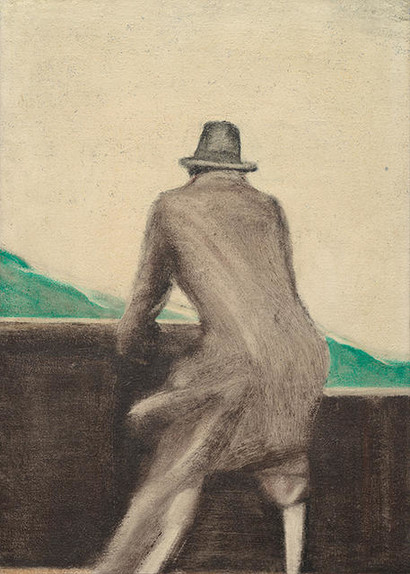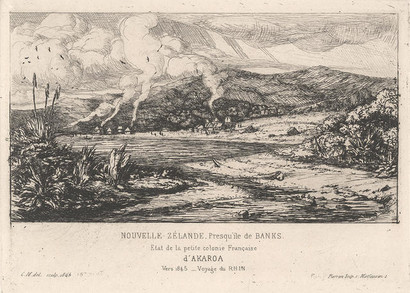
Charles Meryon NOUVELLE- ZÉLANDE Greniers indigènes et habitations à AKAROA (Presqu’île de Banks) 1845 1860. Etching. Collection of Christchurch Art Gallery Te Puna o Waiwhetū 1972
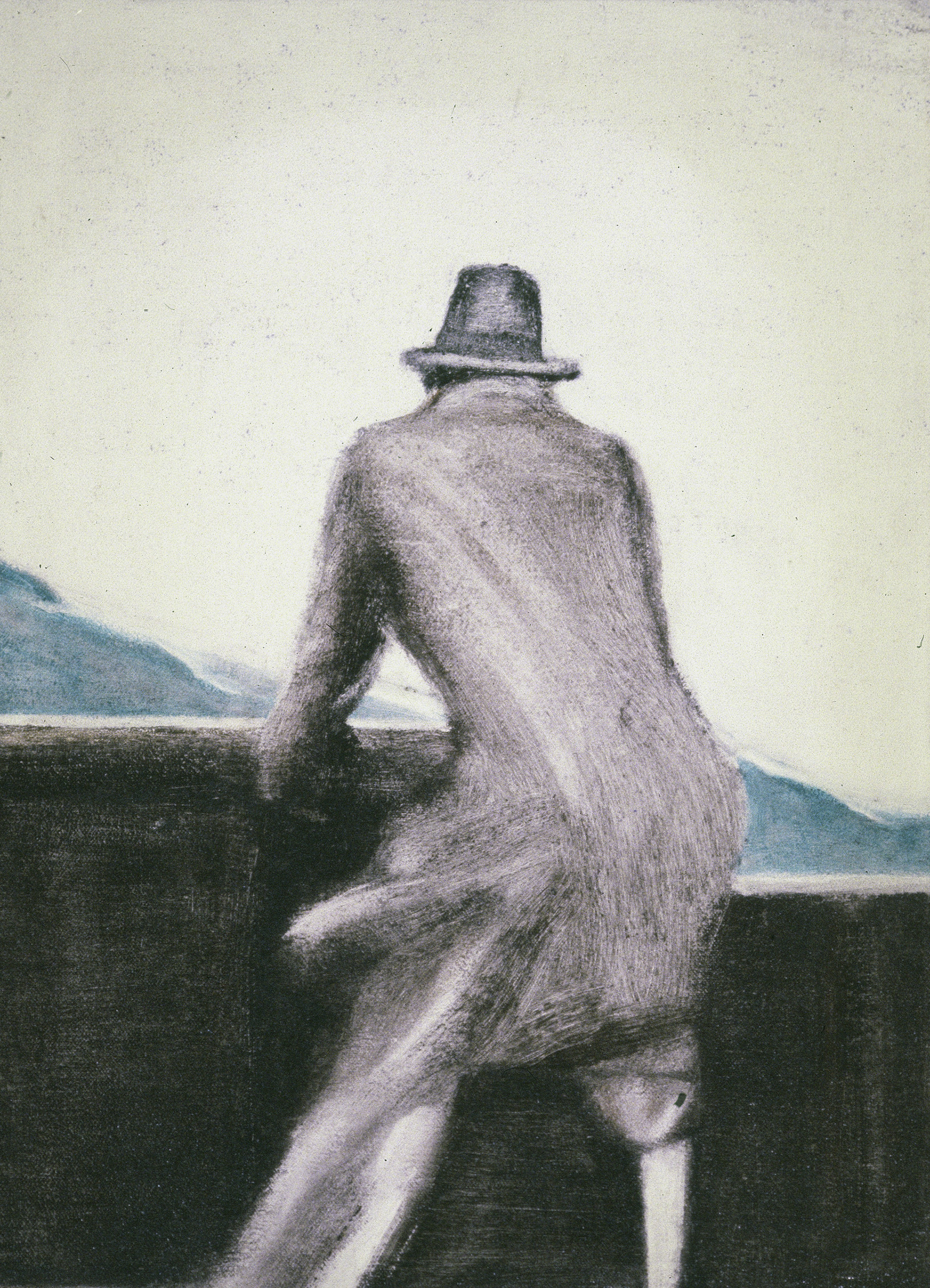
Tony Fomison Captain Ahab Peg Legged Hunter of the White Whale 1981. Oil on canvas board. Collection of Christchurch Art Gallery Te Puna o Waiwhetū, presented to the Gallery by Mr Peter Wells 1984
This exhibition is now closed
Cross-cultural encounter in the Pacific shows whaling as central to the local story.
This selection of works explores early cross-cultural encounter in the Pacific and nineteenth-century European presence and ambition, with whaling as a central part of the local story. Spanning a period of some 180 years, this exhibition links such diverse locations as Paris, Sydney, Niue, Tonga, the Bay of Islands and Banks Peninsula, and brings the past powerfully into the present.
-
Date:
18 December 2015 – 28 August 2016 -
Curator:
Ken Hall -
Exhibition number:
987
Collection works in this exhibition
Related reading: New Zealand, Ka Honoka, exhibition-987
Notes
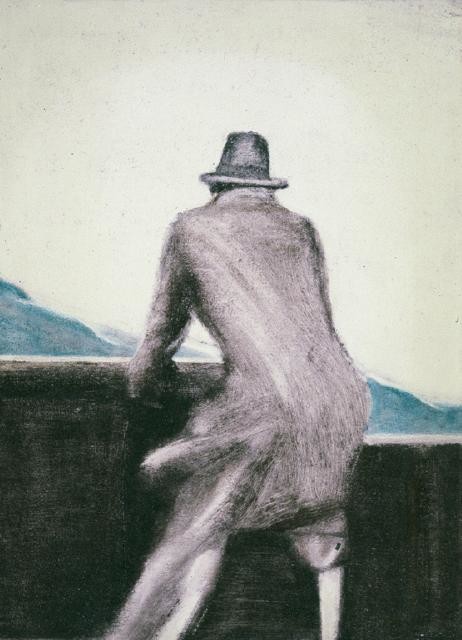
Holiday reading
Herman Melville's Moby Dick, first published on 14 November 1851, is a whale of a book...
Notes
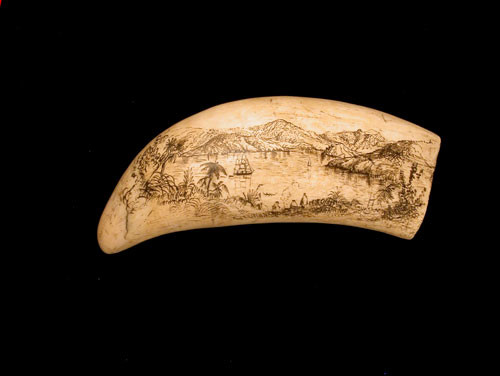
Happy Birthday Akaroa Museum
Big Congratulations to Akaroa Museum on their 50th anniversary which they are celebrating this weekend.
Artist Profile
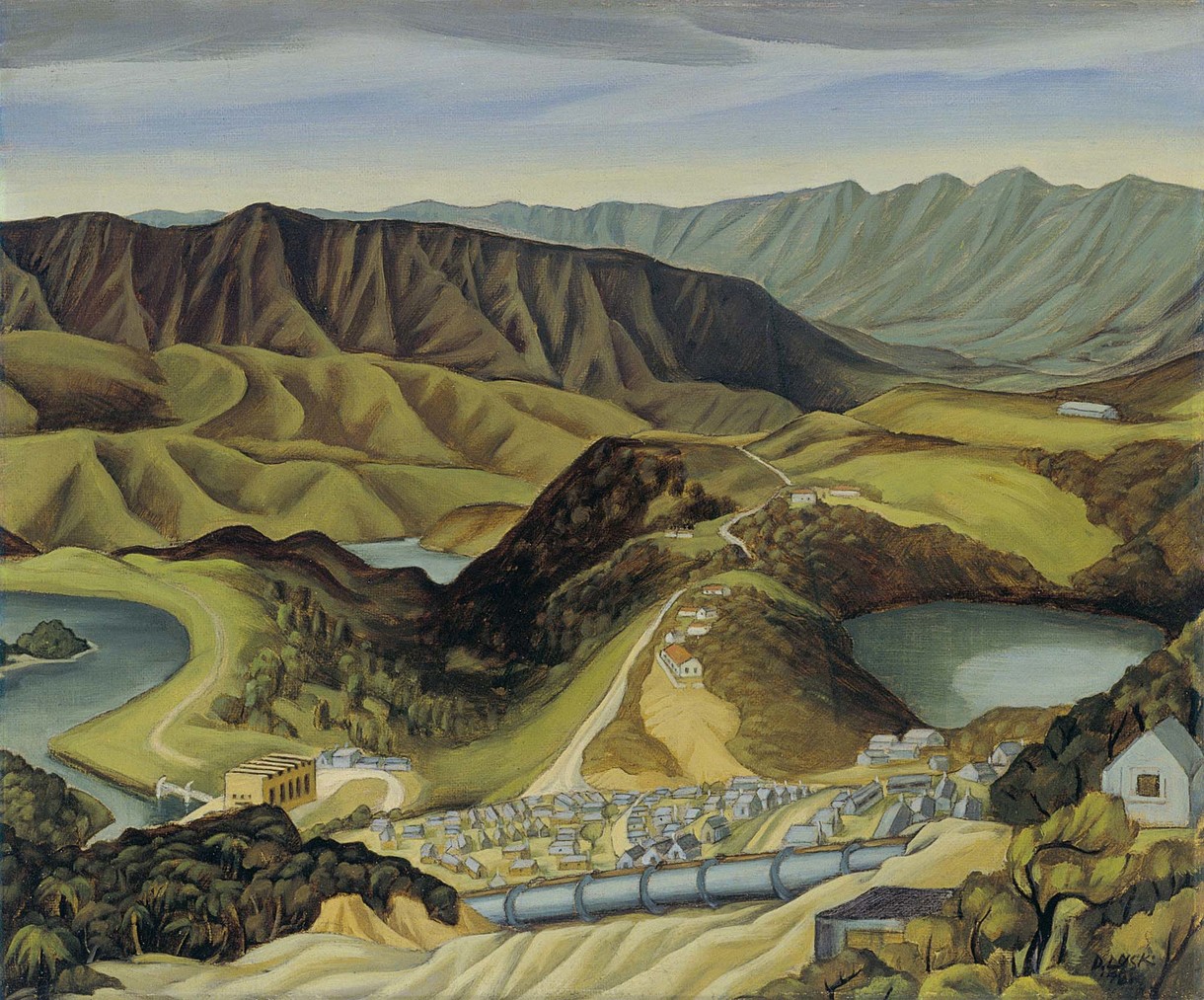
Doris Lusk: An Inventive Eye
In the strange, stunned afterlife that ticked slowly by in the first few years following Christchurch’s February 2011 earthquake, a curious note of recognition sounded through the shock and loss. As a massive programme of demolitions relentlessly hollowed out the city, many buildings were incompletely removed and lingered on for months as melancholy remains – stumps abandoned in a forlorn urban forest. Hideous, sculptural, beautiful; they bore compelling resemblance to a body of paintings created in the city more than three decades earlier.
Article
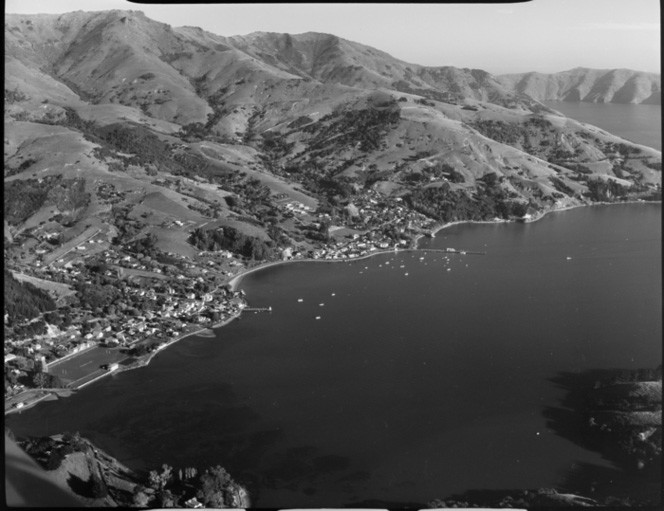
A Tale of Two Chiefs
If you have recently visited He Taonga Rangatira: Noble Treasures at the Gallery you will have been struck by Fiona Pardington's two large photographic portraits of lifelike busts of Ngāi tahu tipuna (ancestors).
Collection
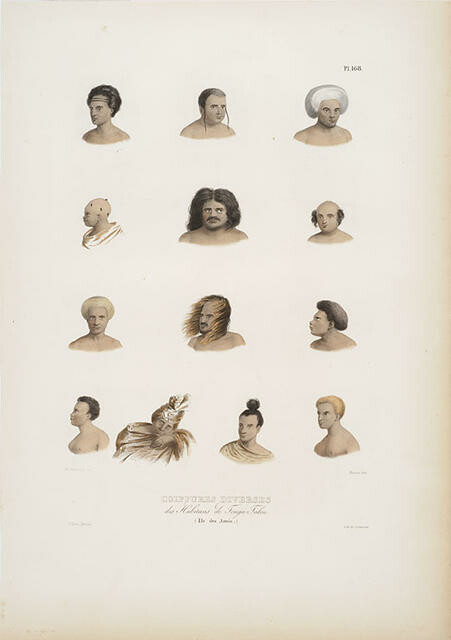
Louis Auguste de Sainson Coiffures diverses des habitans de Tonga Tabou, lle des Amis
Louis Auguste de Sainson was the official artist aboard Captain Dumont d’Urville’s Astrolabe. He spent three months in New Zealand in 1827 on a maritime mapping survey between Tasman Bay and the Bay of Islands, followed by a month in Tonga. A substantial publication on d’Urville’s 1826–29 voyages through Asia and the Pacific was published in Paris in 1833, profusely illustrated by lithographic prints after de Sainson’s drawings.
D’Urville and his crew had close contact with people they met, including the Totaranui chief Tehinui (or Tehi-Noui) and his travelling companion Kokiore (or Koki-Hore) depicted in print 2, who were sketched by de Sainson after coming aboard at Palliser Bay (near present-day Wellington). Tehinui and Kokiore at first both intended to reach Europe, but instead disembarked at Tolaga Bay, later finding their own way home. In summarising his portrait sketching process, de Sainson later recalled: “What I was doing caused a lot of laughter; every minute they tried to escape me.” (Kā Honoka, 18 December 2015 – 28 August 2016)
Collection

Louis Auguste de Sainson Nouvelle-Zélande
Louis Auguste de Sainson was the official artist aboard Captain Dumont d’Urville’s Astrolabe. He spent three months in New Zealand in 1827 on a maritime mapping survey between Tasman Bay and the Bay of Islands, followed by a month in Tonga. A substantial publication on d’Urville’s 1826–29 voyages through Asia and the Pacific was published in Paris in 1833, profusely illustrated by lithographic prints after de Sainson’s drawings.
D’Urville and his crew had close contact with people they met, including the Totaranui chief Tehinui (or Tehi-Noui) and his travelling companion Kokiore (or Koki-Hore) depicted in print 2, who were sketched by de Sainson after coming aboard at Palliser Bay (near present-day Wellington). Tehinui and Kokiore at first both intended to reach Europe, but instead disembarked at Tolaga Bay, later finding their own way home. In summarising his portrait sketching process, de Sainson later recalled: “What I was doing caused a lot of laughter; every minute they tried to escape me.” (Kā Honoka, 18 December 2015 – 28 August 2016)
Collection
![Nouvelle-Zélande - coffre en bois sculpté [Plate 59]](/media/cache/74/c2/74c2c0a963376af9e77d5765ca8842be.jpg)
Louis Auguste de Sainson Nouvelle-Zélande - coffre en bois sculpté [Plate 59]
Louis Auguste de Sainson was the official artist aboard Captain Dumont d’Urville’s Astrolabe. He spent three months in New Zealand in 1827 on a maritime mapping survey between Tasman Bay and the Bay of Islands, followed by a month in Tonga. A substantial publication on d’Urville’s 1826–29 voyages through Asia and the Pacific was published in Paris in 1833, profusely illustrated by lithographic prints after de Sainson’s drawings.
D’Urville and his crew had close contact with people they met, including the Totaranui chief Tehinui (or Tehi-Noui) and his travelling companion Kokiore (or Koki-Hore) depicted in print 2, who were sketched by de Sainson after coming aboard at Palliser Bay (near present-day Wellington). Tehinui and Kokiore at first both intended to reach Europe, but instead disembarked at Tolaga Bay, later finding their own way home. In summarising his portrait sketching process, de Sainson later recalled: “What I was doing caused a lot of laughter; every minute they tried to escape me.” (Kā Honoka, 18 December 2015 – 28 August 2016)
Collection
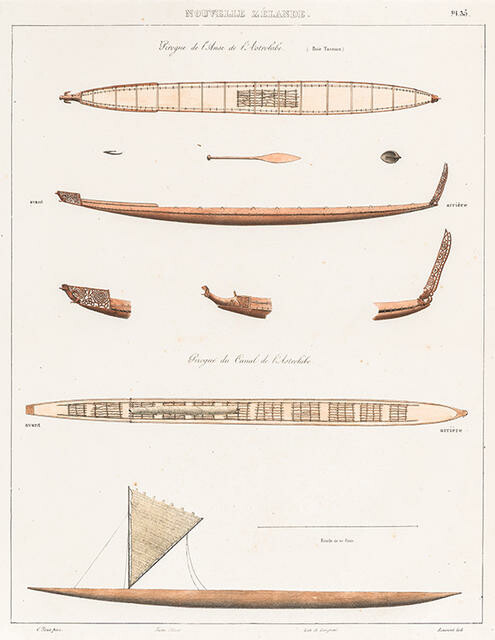
François-Edmond Pâris, Pierre Langlumé, Jean-Antoine Laurent, Joseph Tastu Nouvelle Zélande. Pirogue de L'Anse de l'Astrolabe. (Baie Tasman.), Pirogue du Canal de l'Astrolabe. Pl. 35
Aged just twenty when he joined Dumont d’Urville’s 1826–29 Pacific survey, François-Edmond Pâris created a comprehensive visual record of ships and boats encountered. In 1827 he recorded vessels he saw at Ūawa Tolaga Bay and Paepae-o-Tū Bream Bay, and Te Tai-o-Aorere Tasman Bay and Tāmaki Strait, Auckland.
(Out of Time, 23 September 2023 – 28 April 2024)
Collection
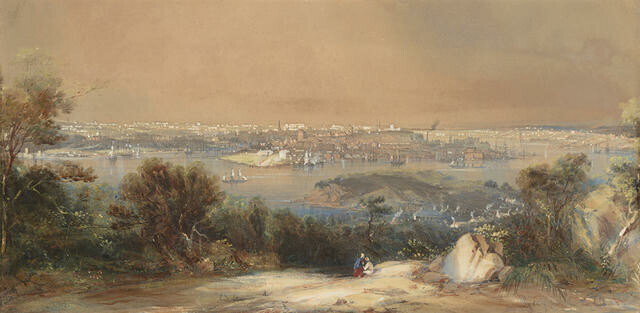
Conrad Martens Sydney from the North Shore
Conrad Martens left England for Rio de Janeiro in 1833. By December had reached Montevideo, Uruguay, where he joined Captain FitzRoy and Charles Darwin on the HMS Beagle, becoming ship’s artist on a survey of South American coasts. In 1835, Martens settled in Sydney and became an admired landscape painter who also produced popular hand-coloured lithographs.
(Out of Time, 23 September 2023 – 28 April 2024)
Collection
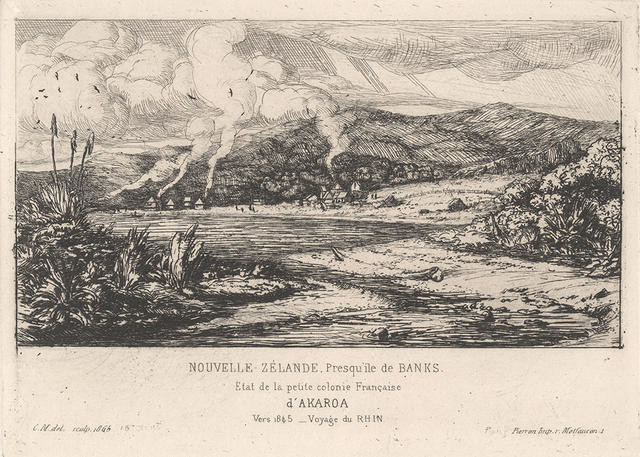
Charles Meryon Nouvelle-Zélande, Presqu’île de Banks. Etat de la petite colonie Française d’Akaroa. Vers 1845 - Voyage du Rhin.
Described as the father of modern etching, French naval officer Charles Meryon was one of the most important artists to work in Waitaha / Canterbury during the colonial era. He served on the Rhin, stationed at Akaroa between 1843 and 1846, to look out for the French settlement there. Meryon made numerous pencil studies at Akaroa which he later used as the basis for this series of etchings completed back in Paris during the 1860s. He planned to publish these and other images of the Pacific in an album, which unfortunately he never completed. The story of the French attempt to settle Te Waipounamu / the South Island is a fascinating chapter in New Zealand’s history. A French whaling captain, Jean Langlois, purchased 30,000 acres from Kāi Tahu on Horomaka / Banks Peninsula in 1838 and returned to France to get government support to establish a French colony at Akaroa. It was from here that he hoped the French would be able to expand throughout the rest of the South Island. A company was formed and sixty- three French and German settlers set sail on the Comte de Paris. They arrived at Akaroa in August 1840 only to find a Union Jack flying at Takapūneke / Green’s Point signalling that British sovereignty had already been claimed. Today, Akaroa continues to retain something of a French flavour.
(Pickaxes and shovels, 17 February – 5 August 2018)








